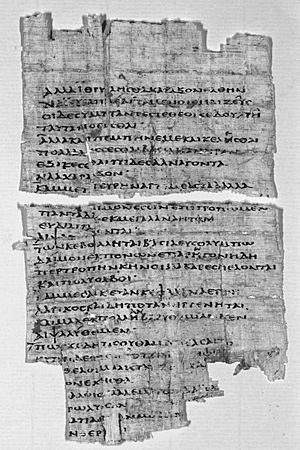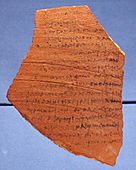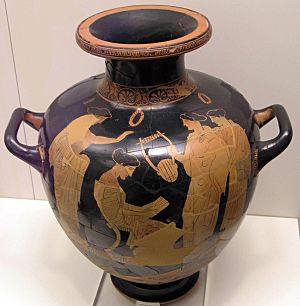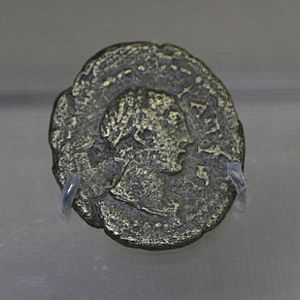Sappho facts for kids
Sappho (/ˈsæfoʊ/; Greek: Σαπφώ Sapphō [sap.pʰɔ̌ː]; Aeolic Greek Ψάπφω Psápphō; c. 630 – c. 570 BC) was an Archaic Greek poet from Eresos or Mytilene on the island of Lesbos. Sappho is known for her lyric poetry, written to be sung while accompanied by music. In ancient times, Sappho was widely regarded as one of the greatest lyric poets and was given names such as the "Tenth Muse" and "The Poetess". Most of Sappho's poetry is now lost, and what is extant has mostly survived in fragmentary form; only the Ode to Aphrodite is certainly complete. As well as lyric poetry, ancient commentators claimed that Sappho wrote elegiac and iambic poetry. Three epigrams formerly attributed to Sappho are extant, but these are actually Hellenistic imitations of Sappho's style.
Little is known of Sappho's life. She was from a wealthy family from Lesbos, though her parents' names are uncertain. Ancient sources say that she had three brothers; Charaxos, Larichos and Eurygios. Two of them, Charaxos and Larichos, are mentioned in the Brothers Poem discovered in 2014. She was exiled to Sicily around 600 BC, and may have continued to work until around 570 BC.
Sappho was a prolific poet, probably composing around 10,000 lines. She was best-known in antiquity for her love poetry; other themes in the surviving fragments of her work include family and religion. She probably wrote poetry for both individual and choral performance. Most of her best-known and best-preserved fragments explore personal emotions and were probably composed for solo performance. Her works are known for their clarity of language, vivid images, and immediacy. The context in which she composed her poems has long been the subject of scholarly debate; the most influential suggestions have been that she had some sort of educational or religious role, or wrote for the symposium.
Sappho's poetry was well-known and greatly admired through much of antiquity, and she was among the canon of Nine Lyric Poets most highly esteemed by scholars of Hellenistic Alexandria. Sappho's poetry is still considered extraordinary and her works continue to influence other writers. Beyond her poetry, she is well known as a symbol of love and desire between women, with the English words sapphic and lesbian deriving from her name and that of her home island respectively.
Contents
Ancient sources
Modern knowledge of Sappho comes both from what can be inferred from her own poetry and from mentions of her in other ancient texts. Her poetry – which, with the exception of a single complete poem, survives only in fragments – is the only contemporary source for her life. The earliest surviving biography of Sappho dates to the late second or early third century AD, approximately eight centuries after her own lifetime; the next is the Suda, a tenth-century Byzantine encyclopedia. Other sources that mention details of her life were written much closer to her own era, beginning in the fifth century BC; one of the earliest is Herodotus' account of the relationship between Rhodopis and Sappho's brother Charaxos. The information about her life recorded in ancient sources was derived from statements in her own poetry that ancient authors assumed were autobiographical, along with local traditions. Some of the ancient traditions about her, such as those about her appearance, may derive from ancient Athenian comedy.
Until the 19th century, ancient biographical accounts of archaic poets' lives were largely accepted as factual. In the 19th century, classicists began to be more sceptical of these traditions, and instead tried to derive biographical information from the poets' own works. In the latter half of the 20th century, scholars became increasingly sceptical of Greek lyric poetry as a source of autobiographical information, questioning whether the first person narrator in the poems was meant to express the experiences and feelings of the poets. Some scholars, such as Mary Lefkowitz, argue that almost nothing can be known about the lives of early Greek poets such as Sappho; most scholars believe that ancient testimonies about poets' lives contain some truth but must be treated with caution.
Life
Little is known about Sappho's life for certain. She was from the island of Lesbos and lived at the end of the seventh and beginning of the sixth centuries BC. This is the date given by most ancient sources, who considered her a contemporary of the poet Alcaeus and the tyrant Pittacus, both also from Lesbos. She therefore may have been born in the third quarter of the seventh century – Franco Ferrari infers a date of around 650 or 640 BC; David Campbell suggests around or before 630 BC. Gregory Hutchinson suggests she was active until around 570 BC.
Tradition names Sappho's mother as Cleïs. This may derive from a now-lost poem or record, though ancient scholars may simply have guessed this name, assuming that Sappho's daughter was named Cleïs after her mother. Ancient sources record ten different names for Sappho's father; this proliferation of possible names suggests that he was not explicitly named in any of her poetry. The earliest and most commonly attested name for him is Scamandronymus. In Ovid's Heroides, Sappho's father died when she was six. He is not mentioned in any of her surviving works, but Campbell suggests that this detail may have been based on a now-lost poem. Her own name is found in numerous variant spellings; the form that appears in her own extant poetry is Psappho (Ψάπφω).
Sappho was said to have three brothers: Eurygios, Larichos, and Charaxos. According to Athenaeus, she praised Larichos for being a cupbearer in the town hall of Mytilene, an office held by boys of the best families. This indication that Sappho was born into an aristocratic family is consistent with the sometimes-rarefied environments that her verses record. One ancient tradition tells of a relationship between Charaxos and Rhodopis. In the fifth century BC Herodotus, the oldest source of the story, reports that Charaxos ransomed Rhodopis for a large sum and that Sappho wrote a poem rebuking him for this. The names of two of the brothers, Charaxos and Larichos, are mentioned in the Brothers Poem, discovered in 2014; the final brother, Eurygios, is mentioned in three ancient sources but nowhere in the extant works of Sappho.
Sappho may have had a daughter named Cleïs, who is referred to in two fragments. Not all scholars accept that Cleïs was Sappho's daughter.
According to the Suda, Sappho was married to Kerkylas of Andros.
One tradition said that Sappho was exiled from Lesbos around 600 BC. The only ancient source for this story is the Parian Chronicle, which records her going into exile in Sicily some time between 604 and 595. This may have been as a result of her family's involvement with the conflicts between political elites on Lesbos in this period. It is unknown which side Sappho's family took in these conflicts, but most scholars believe that they were in the same faction as her contemporary Alcaeus, who was exiled when Myrsilus took power.
Works
Sappho probably wrote around 10,000 lines of poetry; today, only about 650 survive. She is best known for her lyric poetry, written to be accompanied by music. The Suda also attributes to her epigrams, elegiacs, and iambics; three of these epigrams are extant, but are in fact later Hellenistic poems inspired by Sappho. The iambic and elegiac poems attributed to her in the Suda may also be later imitations. Ancient authors claim that she primarily wrote love poetry, and the indirect transmission of her work supports this notion. However, the papyrus tradition suggests that this may not have been the case: a series of papyri published in 2014 contains fragments of ten consecutive poems from an ancient edition of Sappho, of which only two are certainly love poems, while at least three and possibly four are primarily concerned with family.
Ancient editions
It is uncertain when Sappho's poetry was first written down. Some scholars believe that she wrote her own poetry down for future readers; others that if she wrote her works down it was as an aid to reperformance rather than as a work of literature in its own right. In the fifth century BC, Athenian book publishers probably began to produce copies of Lesbian lyric poetry, some including explanatory material and glosses as well as the poems themselves. Some time in the second or third century BC, Alexandrian scholars produced a critical edition of her poetry. There may have been more than one Alexandrian edition – John J. Winkler argues for two, one edited by Aristophanes of Byzantium and another by his pupil Aristarchus of Samothrace. This is not certain – ancient sources tell us that Aristarchus' edition of Alcaeus replaced the edition by Aristophanes, but are silent on whether Sappho's work also went through multiple editions.
The Alexandrian edition of Sappho's poetry may have been based on an Athenian text of her poems, or one from her native Lesbos, and was divided into at least eight books, though the exact number is uncertain. Many modern scholars have followed Denys Page, who conjectured a ninth book in the standard edition; Dimitrios Yatromanolakis doubts this, noting that though ancient sources refer to an eighth book of her poetry, none mention a ninth. The Alexandrian edition of Sappho probably grouped her poems by their metre: ancient sources tell us that each of the first three books contained poems in a single specific metre. Book one of the Alexandrian edition, made up of poems in Sapphic stanzas, seems to have been ordered alphabetically.
Even after the publication of the standard Alexandrian edition, Sappho's poetry continued to circulate in other poetry collections. For instance, the Cologne Papyrus on which the Tithonus poem is preserved was part of a Hellenistic anthology of poetry, which contained poetry arranged by theme, rather than by metre and incipit, as it was in the Alexandrian edition.
Surviving poetry
The earliest surviving manuscripts of Sappho, including the potsherd on which fragment 2 is preserved, date to the third century BC, and thus might predate the Alexandrian edition. The latest surviving copies of her poems transmitted directly from ancient times are written on parchment codex pages from the sixth and seventh centuries AD, and were surely reproduced from ancient papyri now lost. Manuscript copies of her works may have survived a few centuries longer, but around the ninth century her poetry appears to have disappeared, and by the 12th century, John Tzetzes could write that "the passage of time has destroyed Sappho and her works".
According to legend, Sappho's poetry was lost because the church disapproved of her morals. These legends appear to have originated in the Renaissance – around 1550, Jerome Cardan wrote that Gregory Nazianzen had her work publicly destroyed, and at the end of the 16th century Joseph Justus Scaliger claimed that her works were burned in Rome and Constantinople in 1073 on the orders of Pope Gregory VII.
In reality, Sappho's work was probably lost as the demand for it was insufficiently great for it to be copied onto parchment when codices superseded papyrus scrolls as the predominant form of book. A contributing factor to the loss of her poems may have been her Aeolic dialect, considered provincial in a period where the Attic dialect was seen as the true classical Greek, and had become the standard for literary compositions. Consequently, many readers found her dialect difficult to understand: in the second century AD, the Roman author Apuleius specifically remarks on its "strangeness", and several commentaries on the subject demonstrate the difficulties that readers had with it. This was part of a more general decline in interest in the archaic poets; indeed, the surviving papyri suggest that Sappho's poetry survived longer than that of her contemporaries such as Alcaeus.
Only approximately 650 lines of Sappho's poetry still survive, of which just one poem – the Ode to Aphrodite – is complete, and more than half of the original lines survive in around ten more fragments. Many of the surviving fragments of Sappho contain only a single word – for example, fragment 169A is simply a word meaning "wedding gifts" (ἀθρήματα, athremata), and survives as part of a dictionary of rare words. The two major sources of surviving fragments of Sappho are quotations in other ancient works, from a whole poem to as little as a single word, and fragments of papyrus, many of which were rediscovered at Oxyrhynchus in Egypt. Other fragments survive on other materials, including parchment and potsherds. The oldest surviving fragment of Sappho currently known is the Cologne papyrus that contains the Tithonus poem, dating to the third century BC.
Until the last quarter of the 19th century, Sappho's poetry was known only through quotations in the works of other ancient authors. In 1879, the first new discovery of a fragment of Sappho was made at Fayum. By the end of the 19th century, Bernard Pyne Grenfell and Arthur Surridge Hunt had begun to excavate an ancient rubbish dump at Oxyrhynchus, leading to the discoveries of many previously unknown fragments of Sappho. Fragments of Sappho continue to be rediscovered. In the 21st century, major discoveries were made in 2004 (the "Tithonus poem" and a new, previously unknown fragment) and 2014 (fragments of nine poems: five already known but with new readings, four, including the "Brothers Poem", not previously known). Additionally, in 2005 a commentary on her poems on a papyrus from the second or third century AD was published.
Style
He seems like a god to me the man who is near you,
Listening to your sweet voice and exquisite laughter
That makes my heart so wildly beat in my breast.
If I but see you for a moment, then all my words
Leave me, my tongue is broken and a sudden fire
Creeps through my blood. No longer can I see.
My ears are full of noise. In all my body I
Shudder and sweat. I am pale as the sun-scorched
Grass. In my fury I seem like a dead woman,
But I would dare...
— Sappho 31, trans. Edward Storer
Sappho worked within a well-developed tradition of poetry from Lesbos, which had evolved its own poetic diction, metres, and conventions. Prior to Sappho and her contemporary Alcaeus, Lesbos was associated with poetry and music through the mythical Orpheus and Arion, and through the seventh-century BC poet Terpander. The Aeolic metrical tradition in which she composed her poetry was distinct from that of the rest of Greece as its lines always contained a fixed number of syllables – in contrast to other traditions that allowed for the substitution of two short syllables for one long or vice versa.
Sappho was one of the first Greek poets to adopt the "lyric 'I'" – to write poetry adopting the viewpoint of a specific person, in contrast to the earlier poets Homer and Hesiod, who present themselves more as "conduits of divine inspiration". Her poetry explores individual identity and personal emotions – desire, jealousy, and love; it also adopts and reinterprets the existing imagery of epic poetry in exploring these themes. Much of her poetry focuses on the lives and experiences of women. Along with the love poetry for which she is best known, her surviving works include poetry focused on the family, epic-influenced narrative, wedding songs, cult hymns, and invective.
With the exception of a few songs, where the performance context can be deduced from the surviving fragments with some degree of confidence, scholars disagree on how and where Sappho's works were performed. They seem to have been composed for a variety of occasions both public and private, and probably encompassed both solo and choral works. Most of her best-preserved fragments, such as the Ode to Aphrodite, are usually thought to be written for solo performance – though some scholars, such as André Lardinois, believe that most or all of her poems were originally composed for choral performances. These works, which Leslie Kurke describes as "private and informal compositions" in contrast to the public ritual nature of cultic hymns and wedding songs, tend to avoid giving details of a specific chronological, geographical, or occasional setting, which Kurke suggests facilitated their reperformance by performers outside Sappho's original context.
Sappho's poetry is known for its clear language and simple thoughts, sharply-drawn images, and use of direct quotation that brings a sense of immediacy. Unexpected word-play is a characteristic feature of her style. An example is from fragment 96: "now she stands out among Lydian women as after sunset the rose-fingered moon exceeds all stars", a variation of the Homeric epithet "rosy-fingered Dawn". Her poetry often uses hyperbole, according to ancient critics "because of its charm": for example, in fragment 111 she writes that "The groom approaches like Ares [...] Much bigger than a big man".
Kurke groups Sappho with those archaic Greek poets from what has been called the "élite" ideological tradition, which valued luxury (habrosyne) and high birth. These elite poets tended to identify themselves with the worlds of Greek myths, gods, and heroes, as well as the wealthy East, especially Lydia. Thus in fragment 2 she has Aphrodite "pour into golden cups nectar lavishly mingled with joys", while in the Tithonus poem she explicitly states that "I love the finer things [habrosyne]". According to Page duBois, the language, as well as the content, of Sappho's poetry evokes an aristocratic sphere. She contrasts Sappho's "flowery,[...] adorned" style with the "austere, decorous, restrained" style embodied in the works of later classical authors such as Sophocles, Demosthenes, and Pindar.
Music
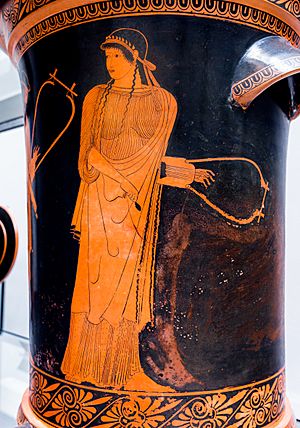
Sappho's poetry was written to be sung, but its musical content is largely uncertain. As it is unlikely that any system of musical notation existed in Ancient Greece before the fifth century, the original music that accompanied her songs probably did not survive until the classical period, and no ancient musical scores to accompany her poetry survive. Sappho reportedly wrote in the mixolydian mode, which was considered sorrowful; it was commonly used in Greek tragedy, and Aristoxenus believed that the tragedians learned it from Sappho. Aristoxenus attributed to Sappho the invention of this mode, but this is unlikely. While there are no attestations that she used other modes, she presumably varied them depending on the poem's character. When originally sung, each syllable of her text likely corresponded to one note as the use of lengthy melismata developed in the later classical period.
Sappho wrote both songs for solo and choral performance. With Alcaeus, she pioneered a new style of sung monody (single-line melody) that departed from the multi-part choral style that largely defined earlier Greek music. This style afforded her more opportunities to individualize the content of her poems; the historian Plutarch noted that she "speaks words mingled truly with fire, and through her songs, she draws up the heat of her heart". Some scholars theorize that the Tithonus poem was among her works meant for a solo singer. Only fragments of Sappho's choral works are extant; of these, her epithalamia (wedding songs) survive better than her cultic hymns. The later compositions were probably meant for antiphonal performance between either a male and female choir or a soloist and choir.
In Sappho's time, sung poetry was usually accompanied by musical instruments, which usually doubled the voice in unison or played homophonically an octave higher or lower. Her poems mention numerous instruments, including the pektis, a harp of Lydian origin, and lyre. Sappho is most closely associated with the barbitos, a lyre-like string instrument that was deep in pitch. Euphorion of Chalcis reports that she referred to it in her poetry, and a fifth-century red-figure vase by either the Dokimasia Painter or Brygos Painter includes Sappho and Alcaeus with barbitoi. Sappho mentions the aulos, a wind instrument with two pipes, in fragment 44 as accompanying the song of the Trojan women at Hector and Andromache's wedding, but not as accompanying her own poetry. Later Greek commentators wrongly believed that she had invented the plectrum.
Social context
One of the major focuses of scholars studying Sappho has been to attempt to determine the cultural context in which Sappho's poems were composed and performed. Various cultural contexts and social roles played by Sappho have been suggested: primarily teacher, priestess, chorus leader, and symposiast. However, the performance contexts of many of Sappho's fragments are not easy to determine, and for many more than one possible context is conceivable.
One longstanding suggestion of a social role for Sappho is that of "Sappho as schoolmistress". This view, popular in the nineteenth and early twentieth centuries, was advocated by the German classicist Ulrich von Wilamowitz-Moellendorff, to "explain away Sappho's passion for her 'girls'" and defend her from accusations of homosexuality. More recently the idea has been criticised by historians as anachronistic and has been rejected by several prominent classicists as unjustified by the evidence. In 1959, Denys Page, for example, stated that Sappho's extant fragments portray "the loves and jealousies, the pleasures and pains, of Sappho and her companions"; and he adds, "We have found, and shall find, no trace of any formal or official or professional relationship between them... no trace of Sappho the principal of an academy." Campbell in 1967 judged that Sappho may have "presided over a literary coterie", but that "evidence for a formal appointment as priestess or teacher is hard to find". None of Sappho's own poetry mentions her teaching, and the earliest source to support the idea of Sappho as a teacher comes from Ovid, six centuries after Sappho's lifetime.
So you hate me now, Atthis, and
Turn towards Andromeda.
— Sappho 131, trans. Edward Storer
In the second half of the twentieth century, scholars began to interpret Sappho as involved in the ritual education of girls, for instance as a trainer of choruses of girls. Though not all of her poems can be interpreted in this light, Lardinois argues that this is the most plausible social context to site Sappho in. Another interpretation which became popular in the twentieth century was of Sappho as a priestess of Aphrodite. However, though Sappho wrote hymns, including some dedicated to Aphrodite, there is no evidence that she held a priesthood. More recent scholars have proposed that Sappho was part of a circle of women who took part in symposia, for which she composed and performed poetry, or that she wrote her poetry to be performed at men's symposia. Though her songs were certainly later performed at symposia, there is no external evidence for archaic Greek women's symposia, and even if some of her works were composed for a sympotic context, it is doubtful that the cultic hymns or poems about family would have been.
Despite scholars' best attempts to find one, Yatromanolakis argues that there is no single performance context to which all of Sappho's poems can be attributed. Camillo Neri argues that it is unnecessary to assign all of her poetry to one context, and suggests that she could have composed poetry both in a pedogogic role and as part of a circle of friends.
Legacy
Ancient reputation
In antiquity, Sappho's poetry was highly admired, and several ancient sources refer to her as the "tenth Muse". The earliest surviving poem to do so is a third-century BC epigram by Dioscorides, but poems are preserved in the Greek Anthology by Antipater of Sidon and attributed to Plato on the same theme. She was sometimes referred to as "The Poetess", just as Homer was "The Poet". The scholars of Alexandria included her in the canon of nine lyric poets. According to Aelian, the Athenian lawmaker and poet Solon asked to be taught a song by Sappho "so that I may learn it and then die". This story may well be apocryphal, especially as Ammianus Marcellinus tells a similar story about Socrates and a song of Stesichorus, but it is indicative of how highly Sappho's poetry was considered in the ancient world.
Sappho's poetry also influenced other ancient authors. Plato cites Sappho in his Phaedrus, and Socrates' second speech on love in that dialogue appears to echo Sappho's descriptions of the physical effects of desire in fragment 31. Many Hellenistic poets alluded to or adapted Sappho's works. The Locrian poet Nossis was described by Marilyn B. Skinner as an imitator of Sappho, and Kathryn Gutzwiller argues that Nossis explicitly positioned herself as an inheritor of Sappho's position as a female poet. Several of Theocritus' poems allude to Sappho, including Idyll 28, which imitates both her language and meter. Poems such as Erinna's Distaff and Callimachus' Lock of Berenice are Sapphic in theme, being concerned with separation – Erinna from her childhood friend; the lock of Berenice's hair from Berenice herself.
In the first century BC, the Roman poet Catullus established the themes and metres of Sappho's poetry as a part of Latin literature, adopting the Sapphic stanza, believed in antiquity to have been invented by Sappho, giving his lover in his poetry the name "Lesbia" in reference to Sappho, and adapting and translating Sappho's 31st fragment in his poem 51. Fragment 31 is widely referenced in Latin literature: as well as by Catullus, it is alluded to by authors including Lucretius in de rerum natura, Plautus in Miles Gloriosus, and Virgil in book 12 of the Aeneid. Latin poets also referenced other fragments: the section on Eppia in Juvenal's sixth satire references fragment 16, a poem in Sapphic stanzas from Statius' Silvae may reference the Ode to Aphrodite, and Horace's Ode 3.27 alludes to fragment 94.
Other ancient poets wrote about Sappho's life. She was a popular character in ancient Athenian comedy, and at least six separate comedies called Sappho are known. The earliest known ancient comedy to take Sappho as its main subject was the early-fifth or late-fourth century BC Sappho by Ameipsias, though nothing is known of it apart from its name. As these comedies survive only in fragments, it is uncertain exactly how they portrayed Sappho. Sappho was also a favourite subject in the visual arts. She was the most commonly depicted poet on sixth and fifth-century Attic red-figure vase paintings – though unlike male poets such as Anacreon and Alcaeus, in the four surviving vases in which she is identified by an inscription she is never shown singing. She was also shown on coins from Mytilene and Eresos from the first to third centuries AD, and reportedly depicted in a sculpture by Silanion at Syracuse, statues in Pergamon and Constantinople, and a painting by the Hellenistic artist Leon.
While Sappho's poetry was admired in the ancient world, her character was not always so well considered. In the Roman period, critics found her lustful and perhaps even homosexual. Horace called her "mascula Sappho" ("masculine Sappho") in his Epistles, which the later Porphyrio commented was "either because she is famous for her poetry, in which men more often excel, or because she is maligned for having been a tribad". By the third century AD, the difference between Sappho's literary reputation as a poet and her moral reputation as a woman had become so significant that the suggestion that there were in fact two Sapphos began to develop.
See also
 In Spanish: Safo de Mitilene para niños
In Spanish: Safo de Mitilene para niños
- Ancient Greek literature
- Papyrus Oxyrhynchus 7 – papyrus preserving Sappho fr. 5
- Papyrus Oxyrhynchus 1231 – papyrus preserving Sappho fr. 15–30




